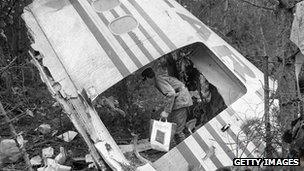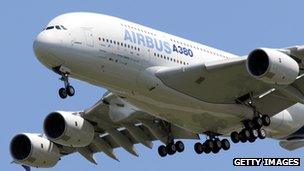Dreamliner trouble: A brief history of airliner problems
- Published
The decision to ground Boeing's latest airliner, the 787 Dreamliner, following a series of serious technical issues has raised questions over the safety of the new aircraft.
Yet it is not the first airliner to enter service and then experience problems. The introduction of new technologies and new material can lead to problems within months of an aircraft beginning airline service.
Not all have fatal consequences, nor do they always result in entire fleets being grounded, but they can have a detrimental effect on an airliner's popularity, reputation and sales.
DeHavilland Comet

The British-made Comet was the world's first commercial jet airliner
Entry into service: 2 May 1952
Problem: Metal fatigue
The Comet was hailed as a great success for British aviation but barely a year after it went into commercial service, disaster struck. In March 1953 a Comet crashed on take-off killing all 11 on board. Two months later another went down a few minutes after take-off from Calcutta killing all 43 people. The following January another dived into the Mediterranean killing 35.
Detailed investigation revealed a devastating design flaw - metal fatigue. The constant stress of repressurisation at high altitude would weaken an area of the fuselage around the Comet's square-shaped windows. The exterior would then become so stressed that high-pressure cabin air would burst through the slightest crack, ripping a large slice in the aircraft's fuselage.
All Comets were grounded, the jets were redesigned and re-entered commercial service in 1958 - with a severely damaged reputation.
McDonnell-Douglas DC-10

More than 340 people died when a DC-10 crashed near Paris in 1974
Entry into service: 5 August 1971
Problem: Sudden loss of cabin pressure
When the first DC-10 was being tested at the firm's factory in Long Beach, California, in May 1970, an incident occurred that would come back and haunt the airliner in the coming decade.
During cabin pressurisation tests, one of the jet's cargo doors blew open and a large section of the cabin floor collapsed. The problem was dismissed at the time as a result of "human failure" and the airliner went on to enter service with American Airlines just over a year later.
Yet in 1972, an American Airlines DC-10 suffered a sudden loss of cabin pressure at 12,000ft and part of the cabin floor collapsed into the cargo hold. Once the aircraft was safely on the ground it was found one of the cargo doors had opened in flight, causing the depressurisation. The incident was blamed by Douglas on the door having been forced shut by a ramp service agent on the ground using his knee.
The US National Transportation Safety Board (NTSB) made two urgent recommendations for changes to the DC-10's cargo doors and Douglas assured the authorities that the changes could be made during regular maintenance checks.
But the crash of a Turkish Airlines' DC-10 10 minutes after take-off from Paris in March 1974 put the cargo door problems in a whole new light. All 346 people on board the flight died.
While the earlier American Airlines crash had led to the NTSB recommending improvements to the cargo door locking mechanism, these had not been carried out on the Turkish Jet,
A failure of the door latch mechanism caused bolts to shear under increasing air pressure. Again the cabin floor collapsed, but this time with fatal consequences, as the cables used to control the aircraft were crippled and the aircraft went into a descending turn before crashing into a forest.
Airbus A380

The A380 is currently the world's largest passenger airliner
Entry into service: 25 October 2007
Problem: Engine failures
The most recent aircraft to experience trouble shortly after entering airline service is Airbus's flagship A380 super-jumbo. Australian airline Qantas grounded its fleet of six A380s after an engine broke apart on a flight to Australia on 4 November 2010. The plane was forced to make an emergency landing in Singapore, and the incident forced all A380 operators to check their aircraft.
Following an investigation, engine manufacturer Rolls-Royce reported two "key conclusions". First, that only the Trent 900 engine was affected; second, that the engine failure "was confined to a specific component" which led to an oil fire and loss of turbine pressure.
In 2011, a second Qantas A380 diverted to Dubai and landed safely after an oil problem forced pilots to shut down one of its four engines.
Problem: Wing cracks
Cracks in the wings of the A380 were first discovered in 2010, following the Qantas engine blow-out. Checks were ordered on all A380s operated by airlines at the time, which revealed more serious problems in around 20 of the airliners.
The European Aviation Safety Agency (EASA) said the planes, a third of the total fleet then flying, would undergo a "visual inspection" for cracks. Airbus said the cracks, in a small number of brackets which connect the internal structure of the wings to the outer skin, were not an immediate threat to safety and any found would be repaired.
The A380s were not grounded as a result of the discovery and Airbus said the problem was down to mistakes made in the choice of material for the brackets. The company says a solution for the problem has been found and aircraft delivered from 2014 onwards will not be affected.
- Published17 January 2013